Managing Diversity: Importance, Challenges, and Rational Goal Theory
VerifiedAdded on 2022/12/14
|11
|3110
|383
AI Summary
This report discusses the importance of managing diversity among staff, the challenges faced by organizations like Sainsbury, and the characteristics of Rational Goal Theory. It explores the impact of diversity on business reputation, conflict resolution, job promotion, and more.
Contribute Materials
Your contribution can guide someone’s learning journey. Share your
documents today.
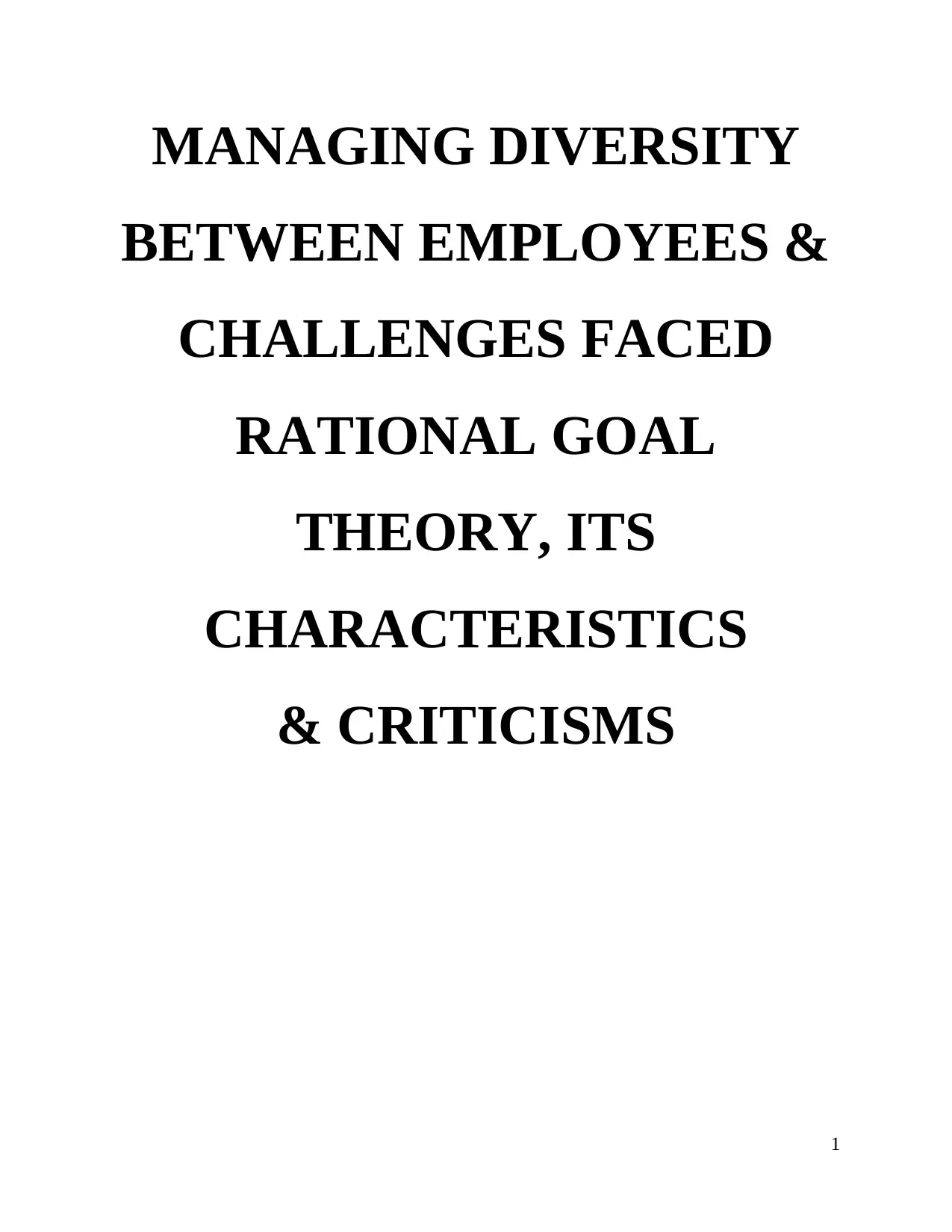
MANAGING DIVERSITY
BETWEEN EMPLOYEES &
CHALLENGES FACED
RATIONAL GOAL
THEORY, ITS
CHARACTERISTICS
& CRITICISMS
1
BETWEEN EMPLOYEES &
CHALLENGES FACED
RATIONAL GOAL
THEORY, ITS
CHARACTERISTICS
& CRITICISMS
1
Secure Best Marks with AI Grader
Need help grading? Try our AI Grader for instant feedback on your assignments.

Table of Contents
INTRODUCTION...........................................................................................................................4
MAIN BODY..................................................................................................................................4
IMPORTANCE OF MANAGING DIVERSITY AMONG STAFF...............................................4
1) INCREASED EXPOSURE TO DIFFERENT KINDS OF PEOPLE...............................4
2) CONFLICT RESOLUTION & REDUCTION.................................................................4
3) JOB PROMOTION & EMPLOYEE DEVELOPMENT..................................................5
4) IMPROVEMENT IN BUSINESS REPUTATION..........................................................5
5) MUTUAL RESPECT AMONG EMPLOYEES...............................................................5
CHALLENGES FACED BY SAINSBURY IN MANAGING DIVERSITY AMONG THE
STAFF:............................................................................................................................................5
1. COMMUNICATION GAP BETWEEN EMPLOYEES......................................................6
2. LINGUISTC BARRIER.......................................................................................................6
3. INCREASES TRAINING AND DEVELOPMENT COST.................................................6
4. LACK OF PROPER MAINTENANCE OF WAGES..........................................................6
5. LACK OF INNOVATION...................................................................................................6
6. RESISTANCE TO CHANGE..............................................................................................7
7. ABSENTEEISM...................................................................................................................7
8. CHALLENGES IN IMPLEMENTING DIVERSITY.........................................................7
RATIONAL GOAL THEORY........................................................................................................8
I. DEFINITE PLAN.................................................................................................................8
II. APPROACH.....................................................................................................................8
III. TECHNIQUES/METHODS.............................................................................................8
IV. CHANGE IN ATTITUDE................................................................................................8
V. EMPHASIS.......................................................................................................................8
CONCLUSION..............................................................................................................................10
REFERENCES..............................................................................................................................11
2
INTRODUCTION...........................................................................................................................4
MAIN BODY..................................................................................................................................4
IMPORTANCE OF MANAGING DIVERSITY AMONG STAFF...............................................4
1) INCREASED EXPOSURE TO DIFFERENT KINDS OF PEOPLE...............................4
2) CONFLICT RESOLUTION & REDUCTION.................................................................4
3) JOB PROMOTION & EMPLOYEE DEVELOPMENT..................................................5
4) IMPROVEMENT IN BUSINESS REPUTATION..........................................................5
5) MUTUAL RESPECT AMONG EMPLOYEES...............................................................5
CHALLENGES FACED BY SAINSBURY IN MANAGING DIVERSITY AMONG THE
STAFF:............................................................................................................................................5
1. COMMUNICATION GAP BETWEEN EMPLOYEES......................................................6
2. LINGUISTC BARRIER.......................................................................................................6
3. INCREASES TRAINING AND DEVELOPMENT COST.................................................6
4. LACK OF PROPER MAINTENANCE OF WAGES..........................................................6
5. LACK OF INNOVATION...................................................................................................6
6. RESISTANCE TO CHANGE..............................................................................................7
7. ABSENTEEISM...................................................................................................................7
8. CHALLENGES IN IMPLEMENTING DIVERSITY.........................................................7
RATIONAL GOAL THEORY........................................................................................................8
I. DEFINITE PLAN.................................................................................................................8
II. APPROACH.....................................................................................................................8
III. TECHNIQUES/METHODS.............................................................................................8
IV. CHANGE IN ATTITUDE................................................................................................8
V. EMPHASIS.......................................................................................................................8
CONCLUSION..............................................................................................................................10
REFERENCES..............................................................................................................................11
2

INTRODUCTION
This report will include the importance of managing diversity among the staff by the
organizations (Roberson, 2019). In the context of the topic, some of the challenges faced by
Sainsbury supermarket in managing the diversity among their employees will also be studied.
Further, Scientific management practice adopted by the organizations will be studies. The
characteristics of Rational Goal theory will be highlighted based on the situation that it still
continues to exist in some organizations despite having its limitations.
MAIN BODY
With the emerging and expanding marketplace, the best strategy adopted by
organizations to gain a competitive advantage over others is through diversifying its workforce.
Every organization has employees coming from various backgrounds, having different
experiences and perspectives on different matters. Diversification at workplace is a need not just
because it benefits the business but also it creates value for the company which brings in
innovation though great professionals. Moreover, it promotes individuality among the employees
so that every individual can present their creative and different ideas. Employees have some
underlying interest to work in a particular organization, and they also expect to reap some gains
from it (Triana, 2017). After discussing some of the features of managing diversity between
persons, now let’s discuss;
IMPORTANCE OF MANAGING DIVERSITY AMONG STAFF
1) INCREASED EXPOSURE TO DIFFERENT KINDS OF PEOPLE
An organization having diversified workforce, where employees have different styles to work
and each style varies from the other, it gives them an opportunity to learn from their co-workers.
They can learn new skills, develop interpersonal relationships and mutual understanding towards
each other. Take for an example, workers having advanced knowledge of technology can help
learn new ways and processes to other workers who are unable to get full access to technology.
3
This report will include the importance of managing diversity among the staff by the
organizations (Roberson, 2019). In the context of the topic, some of the challenges faced by
Sainsbury supermarket in managing the diversity among their employees will also be studied.
Further, Scientific management practice adopted by the organizations will be studies. The
characteristics of Rational Goal theory will be highlighted based on the situation that it still
continues to exist in some organizations despite having its limitations.
MAIN BODY
With the emerging and expanding marketplace, the best strategy adopted by
organizations to gain a competitive advantage over others is through diversifying its workforce.
Every organization has employees coming from various backgrounds, having different
experiences and perspectives on different matters. Diversification at workplace is a need not just
because it benefits the business but also it creates value for the company which brings in
innovation though great professionals. Moreover, it promotes individuality among the employees
so that every individual can present their creative and different ideas. Employees have some
underlying interest to work in a particular organization, and they also expect to reap some gains
from it (Triana, 2017). After discussing some of the features of managing diversity between
persons, now let’s discuss;
IMPORTANCE OF MANAGING DIVERSITY AMONG STAFF
1) INCREASED EXPOSURE TO DIFFERENT KINDS OF PEOPLE
An organization having diversified workforce, where employees have different styles to work
and each style varies from the other, it gives them an opportunity to learn from their co-workers.
They can learn new skills, develop interpersonal relationships and mutual understanding towards
each other. Take for an example, workers having advanced knowledge of technology can help
learn new ways and processes to other workers who are unable to get full access to technology.
3
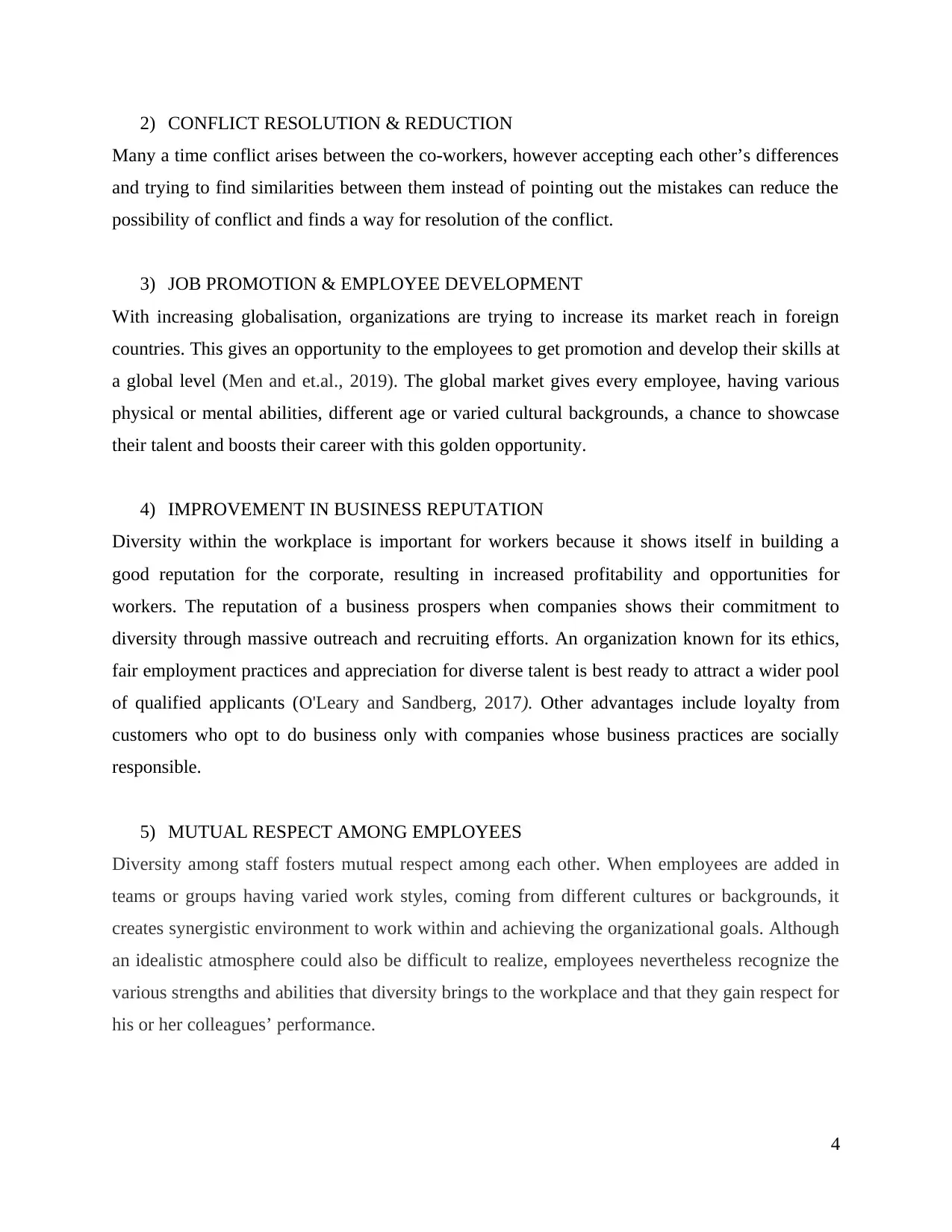
2) CONFLICT RESOLUTION & REDUCTION
Many a time conflict arises between the co-workers, however accepting each other’s differences
and trying to find similarities between them instead of pointing out the mistakes can reduce the
possibility of conflict and finds a way for resolution of the conflict.
3) JOB PROMOTION & EMPLOYEE DEVELOPMENT
With increasing globalisation, organizations are trying to increase its market reach in foreign
countries. This gives an opportunity to the employees to get promotion and develop their skills at
a global level (Men and et.al., 2019). The global market gives every employee, having various
physical or mental abilities, different age or varied cultural backgrounds, a chance to showcase
their talent and boosts their career with this golden opportunity.
4) IMPROVEMENT IN BUSINESS REPUTATION
Diversity within the workplace is important for workers because it shows itself in building a
good reputation for the corporate, resulting in increased profitability and opportunities for
workers. The reputation of a business prospers when companies shows their commitment to
diversity through massive outreach and recruiting efforts. An organization known for its ethics,
fair employment practices and appreciation for diverse talent is best ready to attract a wider pool
of qualified applicants (O'Leary and Sandberg, 2017). Other advantages include loyalty from
customers who opt to do business only with companies whose business practices are socially
responsible.
5) MUTUAL RESPECT AMONG EMPLOYEES
Diversity among staff fosters mutual respect among each other. When employees are added in
teams or groups having varied work styles, coming from different cultures or backgrounds, it
creates synergistic environment to work within and achieving the organizational goals. Although
an idealistic atmosphere could also be difficult to realize, employees nevertheless recognize the
various strengths and abilities that diversity brings to the workplace and that they gain respect for
his or her colleagues’ performance.
4
Many a time conflict arises between the co-workers, however accepting each other’s differences
and trying to find similarities between them instead of pointing out the mistakes can reduce the
possibility of conflict and finds a way for resolution of the conflict.
3) JOB PROMOTION & EMPLOYEE DEVELOPMENT
With increasing globalisation, organizations are trying to increase its market reach in foreign
countries. This gives an opportunity to the employees to get promotion and develop their skills at
a global level (Men and et.al., 2019). The global market gives every employee, having various
physical or mental abilities, different age or varied cultural backgrounds, a chance to showcase
their talent and boosts their career with this golden opportunity.
4) IMPROVEMENT IN BUSINESS REPUTATION
Diversity within the workplace is important for workers because it shows itself in building a
good reputation for the corporate, resulting in increased profitability and opportunities for
workers. The reputation of a business prospers when companies shows their commitment to
diversity through massive outreach and recruiting efforts. An organization known for its ethics,
fair employment practices and appreciation for diverse talent is best ready to attract a wider pool
of qualified applicants (O'Leary and Sandberg, 2017). Other advantages include loyalty from
customers who opt to do business only with companies whose business practices are socially
responsible.
5) MUTUAL RESPECT AMONG EMPLOYEES
Diversity among staff fosters mutual respect among each other. When employees are added in
teams or groups having varied work styles, coming from different cultures or backgrounds, it
creates synergistic environment to work within and achieving the organizational goals. Although
an idealistic atmosphere could also be difficult to realize, employees nevertheless recognize the
various strengths and abilities that diversity brings to the workplace and that they gain respect for
his or her colleagues’ performance.
4
Secure Best Marks with AI Grader
Need help grading? Try our AI Grader for instant feedback on your assignments.
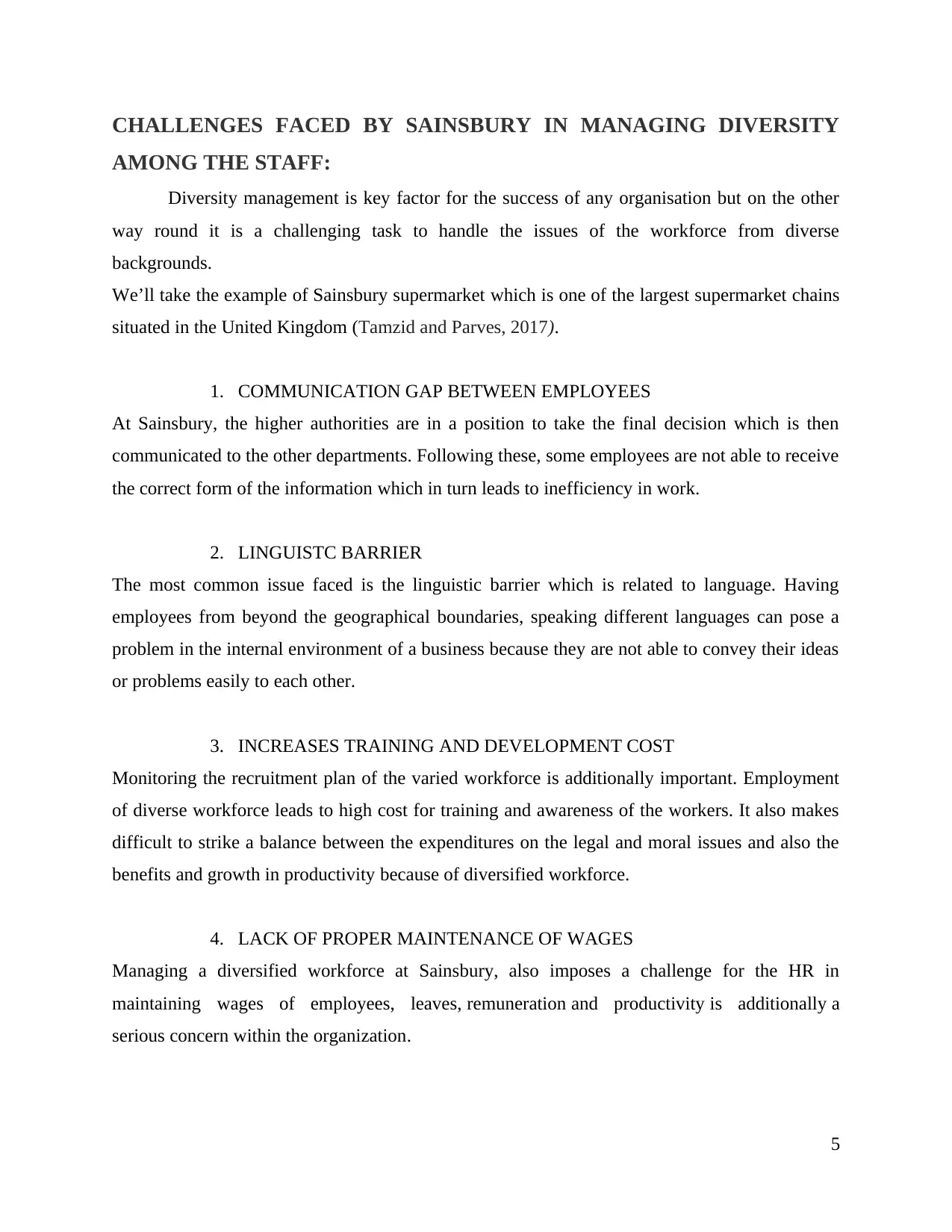
CHALLENGES FACED BY SAINSBURY IN MANAGING DIVERSITY
AMONG THE STAFF:
Diversity management is key factor for the success of any organisation but on the other
way round it is a challenging task to handle the issues of the workforce from diverse
backgrounds.
We’ll take the example of Sainsbury supermarket which is one of the largest supermarket chains
situated in the United Kingdom (Tamzid and Parves, 2017).
1. COMMUNICATION GAP BETWEEN EMPLOYEES
At Sainsbury, the higher authorities are in a position to take the final decision which is then
communicated to the other departments. Following these, some employees are not able to receive
the correct form of the information which in turn leads to inefficiency in work.
2. LINGUISTC BARRIER
The most common issue faced is the linguistic barrier which is related to language. Having
employees from beyond the geographical boundaries, speaking different languages can pose a
problem in the internal environment of a business because they are not able to convey their ideas
or problems easily to each other.
3. INCREASES TRAINING AND DEVELOPMENT COST
Monitoring the recruitment plan of the varied workforce is additionally important. Employment
of diverse workforce leads to high cost for training and awareness of the workers. It also makes
difficult to strike a balance between the expenditures on the legal and moral issues and also the
benefits and growth in productivity because of diversified workforce.
4. LACK OF PROPER MAINTENANCE OF WAGES
Managing a diversified workforce at Sainsbury, also imposes a challenge for the HR in
maintaining wages of employees, leaves, remuneration and productivity is additionally a
serious concern within the organization.
5
AMONG THE STAFF:
Diversity management is key factor for the success of any organisation but on the other
way round it is a challenging task to handle the issues of the workforce from diverse
backgrounds.
We’ll take the example of Sainsbury supermarket which is one of the largest supermarket chains
situated in the United Kingdom (Tamzid and Parves, 2017).
1. COMMUNICATION GAP BETWEEN EMPLOYEES
At Sainsbury, the higher authorities are in a position to take the final decision which is then
communicated to the other departments. Following these, some employees are not able to receive
the correct form of the information which in turn leads to inefficiency in work.
2. LINGUISTC BARRIER
The most common issue faced is the linguistic barrier which is related to language. Having
employees from beyond the geographical boundaries, speaking different languages can pose a
problem in the internal environment of a business because they are not able to convey their ideas
or problems easily to each other.
3. INCREASES TRAINING AND DEVELOPMENT COST
Monitoring the recruitment plan of the varied workforce is additionally important. Employment
of diverse workforce leads to high cost for training and awareness of the workers. It also makes
difficult to strike a balance between the expenditures on the legal and moral issues and also the
benefits and growth in productivity because of diversified workforce.
4. LACK OF PROPER MAINTENANCE OF WAGES
Managing a diversified workforce at Sainsbury, also imposes a challenge for the HR in
maintaining wages of employees, leaves, remuneration and productivity is additionally a
serious concern within the organization.
5

5. LACK OF INNOVATION
Despite Sainsbury’s earlier entry into the market as compared to Tesco and ASDA, it's didn't
develop new ideas and techniques that can foster its position within the industry. As the internal
issues faced by employees didn’t allow them space to think creatively, Sainsbury faced a setback
as it was not able to innovate and change itself according to the needs of market (Karim, Rahman
and Mubeen, 2019). For this reason, it lost the leading position within the industry after being
replaced by Tesco.
6. RESISTANCE TO CHANGE
Many employees at Sainsbury have their own beliefs and thoughts so they put a barrier in
adapting to new changes. They always have a mentality ‘they always used to do that work’
which imposes a challenge to accept new and innovative work practices.
7. ABSENTEEISM
Due to its poor management often, Sainsbury lacks behind in the market competition, which in
turn increases its maintenance costs. To cut its costs, it introduces pay cuts and wage deduction
which demotivates the employees towards work. This makes employees feel to not perform up to
the mark that negatively impacts the organization. Many shop floor workers also face the risk of
losing their jobs. Their lacks the security of jobs for the employees working at Sainsbury.
8. CHALLENGES IN IMPLEMENTING DIVERSITY
Creating plans and strategies to build diversity is easy but implementing that in real is a major
problem. There is not a single diversity plan that can fit in an organization as every person has
his own definition of diversity (Trehan and Glover, 2019). Employees will never opt for change
until the management makes them understand the need of doing it. This is the best possible way
to implement diversity among the employees.
6
Despite Sainsbury’s earlier entry into the market as compared to Tesco and ASDA, it's didn't
develop new ideas and techniques that can foster its position within the industry. As the internal
issues faced by employees didn’t allow them space to think creatively, Sainsbury faced a setback
as it was not able to innovate and change itself according to the needs of market (Karim, Rahman
and Mubeen, 2019). For this reason, it lost the leading position within the industry after being
replaced by Tesco.
6. RESISTANCE TO CHANGE
Many employees at Sainsbury have their own beliefs and thoughts so they put a barrier in
adapting to new changes. They always have a mentality ‘they always used to do that work’
which imposes a challenge to accept new and innovative work practices.
7. ABSENTEEISM
Due to its poor management often, Sainsbury lacks behind in the market competition, which in
turn increases its maintenance costs. To cut its costs, it introduces pay cuts and wage deduction
which demotivates the employees towards work. This makes employees feel to not perform up to
the mark that negatively impacts the organization. Many shop floor workers also face the risk of
losing their jobs. Their lacks the security of jobs for the employees working at Sainsbury.
8. CHALLENGES IN IMPLEMENTING DIVERSITY
Creating plans and strategies to build diversity is easy but implementing that in real is a major
problem. There is not a single diversity plan that can fit in an organization as every person has
his own definition of diversity (Trehan and Glover, 2019). Employees will never opt for change
until the management makes them understand the need of doing it. This is the best possible way
to implement diversity among the employees.
6
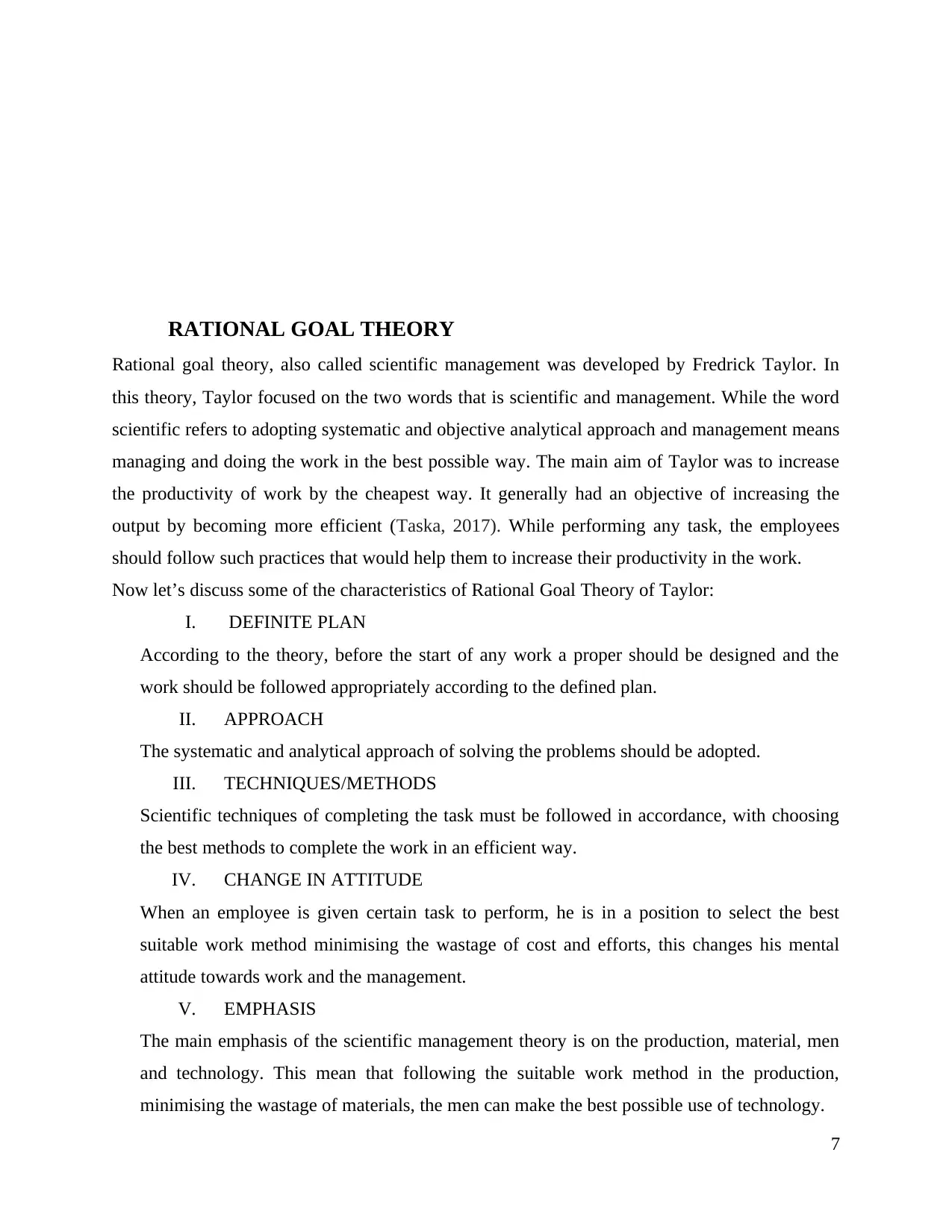
RATIONAL GOAL THEORY
Rational goal theory, also called scientific management was developed by Fredrick Taylor. In
this theory, Taylor focused on the two words that is scientific and management. While the word
scientific refers to adopting systematic and objective analytical approach and management means
managing and doing the work in the best possible way. The main aim of Taylor was to increase
the productivity of work by the cheapest way. It generally had an objective of increasing the
output by becoming more efficient (Taska, 2017). While performing any task, the employees
should follow such practices that would help them to increase their productivity in the work.
Now let’s discuss some of the characteristics of Rational Goal Theory of Taylor:
I. DEFINITE PLAN
According to the theory, before the start of any work a proper should be designed and the
work should be followed appropriately according to the defined plan.
II. APPROACH
The systematic and analytical approach of solving the problems should be adopted.
III. TECHNIQUES/METHODS
Scientific techniques of completing the task must be followed in accordance, with choosing
the best methods to complete the work in an efficient way.
IV. CHANGE IN ATTITUDE
When an employee is given certain task to perform, he is in a position to select the best
suitable work method minimising the wastage of cost and efforts, this changes his mental
attitude towards work and the management.
V. EMPHASIS
The main emphasis of the scientific management theory is on the production, material, men
and technology. This mean that following the suitable work method in the production,
minimising the wastage of materials, the men can make the best possible use of technology.
7
Rational goal theory, also called scientific management was developed by Fredrick Taylor. In
this theory, Taylor focused on the two words that is scientific and management. While the word
scientific refers to adopting systematic and objective analytical approach and management means
managing and doing the work in the best possible way. The main aim of Taylor was to increase
the productivity of work by the cheapest way. It generally had an objective of increasing the
output by becoming more efficient (Taska, 2017). While performing any task, the employees
should follow such practices that would help them to increase their productivity in the work.
Now let’s discuss some of the characteristics of Rational Goal Theory of Taylor:
I. DEFINITE PLAN
According to the theory, before the start of any work a proper should be designed and the
work should be followed appropriately according to the defined plan.
II. APPROACH
The systematic and analytical approach of solving the problems should be adopted.
III. TECHNIQUES/METHODS
Scientific techniques of completing the task must be followed in accordance, with choosing
the best methods to complete the work in an efficient way.
IV. CHANGE IN ATTITUDE
When an employee is given certain task to perform, he is in a position to select the best
suitable work method minimising the wastage of cost and efforts, this changes his mental
attitude towards work and the management.
V. EMPHASIS
The main emphasis of the scientific management theory is on the production, material, men
and technology. This mean that following the suitable work method in the production,
minimising the wastage of materials, the men can make the best possible use of technology.
7
Paraphrase This Document
Need a fresh take? Get an instant paraphrase of this document with our AI Paraphraser
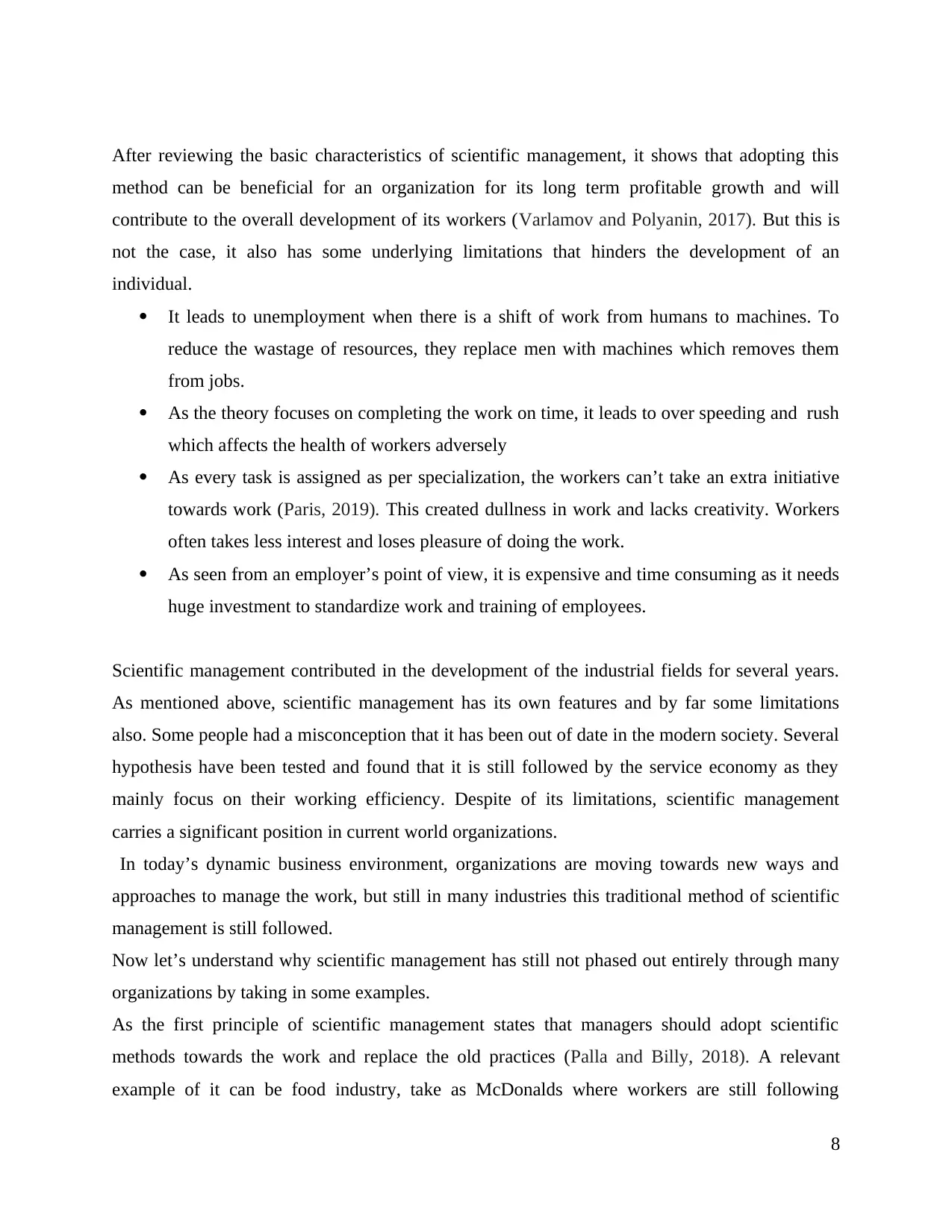
After reviewing the basic characteristics of scientific management, it shows that adopting this
method can be beneficial for an organization for its long term profitable growth and will
contribute to the overall development of its workers (Varlamov and Polyanin, 2017). But this is
not the case, it also has some underlying limitations that hinders the development of an
individual.
It leads to unemployment when there is a shift of work from humans to machines. To
reduce the wastage of resources, they replace men with machines which removes them
from jobs.
As the theory focuses on completing the work on time, it leads to over speeding and rush
which affects the health of workers adversely
As every task is assigned as per specialization, the workers can’t take an extra initiative
towards work (Paris, 2019). This created dullness in work and lacks creativity. Workers
often takes less interest and loses pleasure of doing the work.
As seen from an employer’s point of view, it is expensive and time consuming as it needs
huge investment to standardize work and training of employees.
Scientific management contributed in the development of the industrial fields for several years.
As mentioned above, scientific management has its own features and by far some limitations
also. Some people had a misconception that it has been out of date in the modern society. Several
hypothesis have been tested and found that it is still followed by the service economy as they
mainly focus on their working efficiency. Despite of its limitations, scientific management
carries a significant position in current world organizations.
In today’s dynamic business environment, organizations are moving towards new ways and
approaches to manage the work, but still in many industries this traditional method of scientific
management is still followed.
Now let’s understand why scientific management has still not phased out entirely through many
organizations by taking in some examples.
As the first principle of scientific management states that managers should adopt scientific
methods towards the work and replace the old practices (Palla and Billy, 2018). A relevant
example of it can be food industry, take as McDonalds where workers are still following
8
method can be beneficial for an organization for its long term profitable growth and will
contribute to the overall development of its workers (Varlamov and Polyanin, 2017). But this is
not the case, it also has some underlying limitations that hinders the development of an
individual.
It leads to unemployment when there is a shift of work from humans to machines. To
reduce the wastage of resources, they replace men with machines which removes them
from jobs.
As the theory focuses on completing the work on time, it leads to over speeding and rush
which affects the health of workers adversely
As every task is assigned as per specialization, the workers can’t take an extra initiative
towards work (Paris, 2019). This created dullness in work and lacks creativity. Workers
often takes less interest and loses pleasure of doing the work.
As seen from an employer’s point of view, it is expensive and time consuming as it needs
huge investment to standardize work and training of employees.
Scientific management contributed in the development of the industrial fields for several years.
As mentioned above, scientific management has its own features and by far some limitations
also. Some people had a misconception that it has been out of date in the modern society. Several
hypothesis have been tested and found that it is still followed by the service economy as they
mainly focus on their working efficiency. Despite of its limitations, scientific management
carries a significant position in current world organizations.
In today’s dynamic business environment, organizations are moving towards new ways and
approaches to manage the work, but still in many industries this traditional method of scientific
management is still followed.
Now let’s understand why scientific management has still not phased out entirely through many
organizations by taking in some examples.
As the first principle of scientific management states that managers should adopt scientific
methods towards the work and replace the old practices (Palla and Billy, 2018). A relevant
example of it can be food industry, take as McDonalds where workers are still following
8
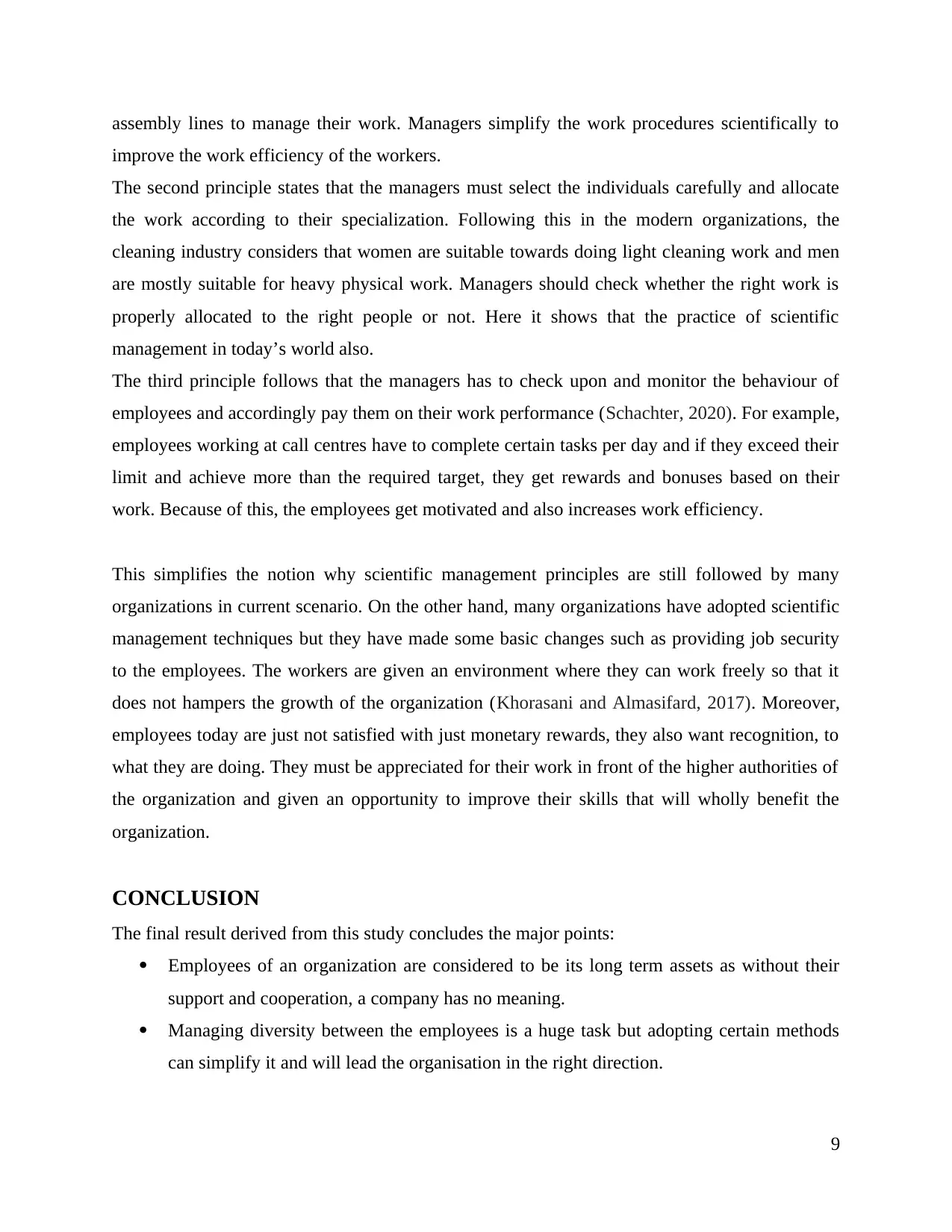
assembly lines to manage their work. Managers simplify the work procedures scientifically to
improve the work efficiency of the workers.
The second principle states that the managers must select the individuals carefully and allocate
the work according to their specialization. Following this in the modern organizations, the
cleaning industry considers that women are suitable towards doing light cleaning work and men
are mostly suitable for heavy physical work. Managers should check whether the right work is
properly allocated to the right people or not. Here it shows that the practice of scientific
management in today’s world also.
The third principle follows that the managers has to check upon and monitor the behaviour of
employees and accordingly pay them on their work performance (Schachter, 2020). For example,
employees working at call centres have to complete certain tasks per day and if they exceed their
limit and achieve more than the required target, they get rewards and bonuses based on their
work. Because of this, the employees get motivated and also increases work efficiency.
This simplifies the notion why scientific management principles are still followed by many
organizations in current scenario. On the other hand, many organizations have adopted scientific
management techniques but they have made some basic changes such as providing job security
to the employees. The workers are given an environment where they can work freely so that it
does not hampers the growth of the organization (Khorasani and Almasifard, 2017). Moreover,
employees today are just not satisfied with just monetary rewards, they also want recognition, to
what they are doing. They must be appreciated for their work in front of the higher authorities of
the organization and given an opportunity to improve their skills that will wholly benefit the
organization.
CONCLUSION
The final result derived from this study concludes the major points:
Employees of an organization are considered to be its long term assets as without their
support and cooperation, a company has no meaning.
Managing diversity between the employees is a huge task but adopting certain methods
can simplify it and will lead the organisation in the right direction.
9
improve the work efficiency of the workers.
The second principle states that the managers must select the individuals carefully and allocate
the work according to their specialization. Following this in the modern organizations, the
cleaning industry considers that women are suitable towards doing light cleaning work and men
are mostly suitable for heavy physical work. Managers should check whether the right work is
properly allocated to the right people or not. Here it shows that the practice of scientific
management in today’s world also.
The third principle follows that the managers has to check upon and monitor the behaviour of
employees and accordingly pay them on their work performance (Schachter, 2020). For example,
employees working at call centres have to complete certain tasks per day and if they exceed their
limit and achieve more than the required target, they get rewards and bonuses based on their
work. Because of this, the employees get motivated and also increases work efficiency.
This simplifies the notion why scientific management principles are still followed by many
organizations in current scenario. On the other hand, many organizations have adopted scientific
management techniques but they have made some basic changes such as providing job security
to the employees. The workers are given an environment where they can work freely so that it
does not hampers the growth of the organization (Khorasani and Almasifard, 2017). Moreover,
employees today are just not satisfied with just monetary rewards, they also want recognition, to
what they are doing. They must be appreciated for their work in front of the higher authorities of
the organization and given an opportunity to improve their skills that will wholly benefit the
organization.
CONCLUSION
The final result derived from this study concludes the major points:
Employees of an organization are considered to be its long term assets as without their
support and cooperation, a company has no meaning.
Managing diversity between the employees is a huge task but adopting certain methods
can simplify it and will lead the organisation in the right direction.
9
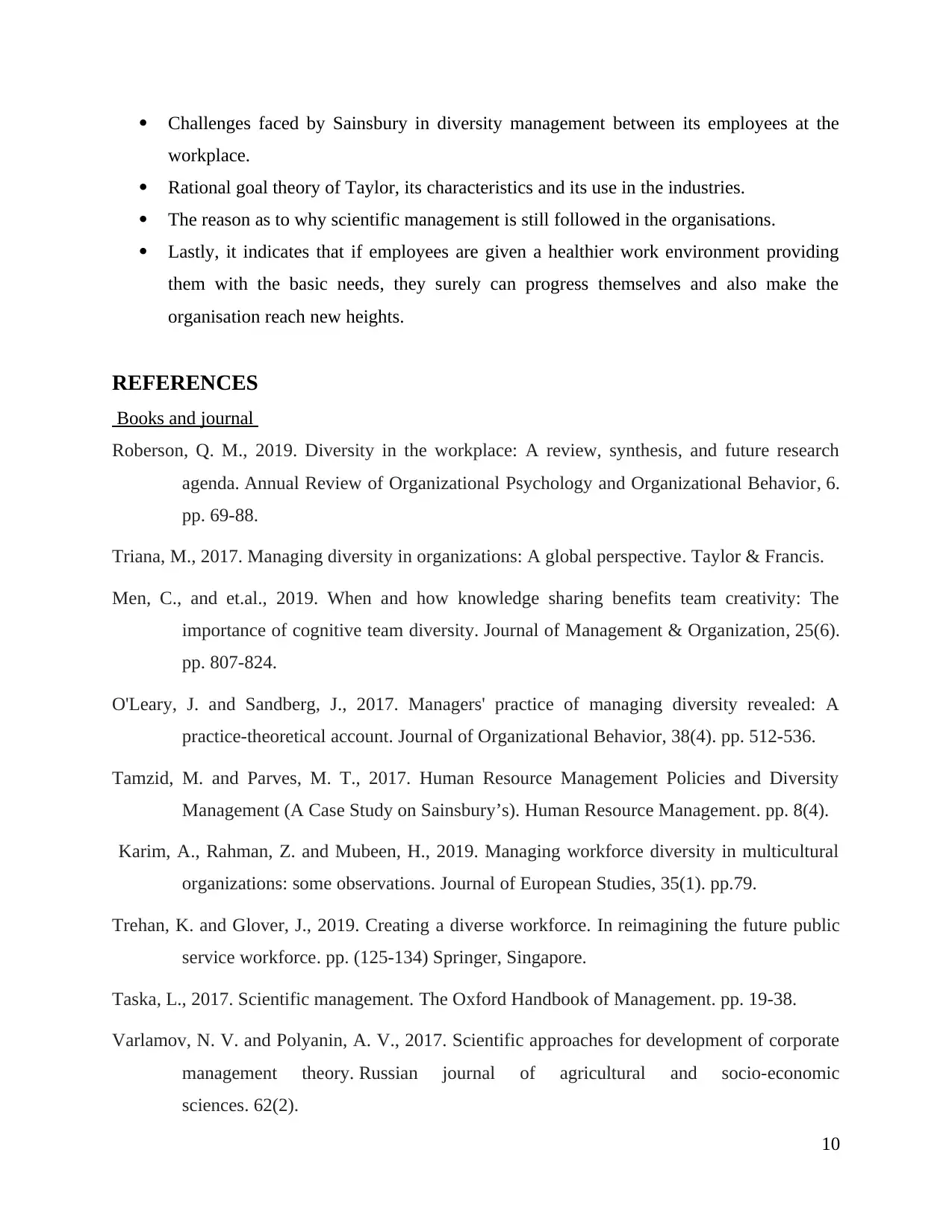
Challenges faced by Sainsbury in diversity management between its employees at the
workplace.
Rational goal theory of Taylor, its characteristics and its use in the industries.
The reason as to why scientific management is still followed in the organisations.
Lastly, it indicates that if employees are given a healthier work environment providing
them with the basic needs, they surely can progress themselves and also make the
organisation reach new heights.
REFERENCES
Books and journal
Roberson, Q. M., 2019. Diversity in the workplace: A review, synthesis, and future research
agenda. Annual Review of Organizational Psychology and Organizational Behavior, 6.
pp. 69-88.
Triana, M., 2017. Managing diversity in organizations: A global perspective. Taylor & Francis.
Men, C., and et.al., 2019. When and how knowledge sharing benefits team creativity: The
importance of cognitive team diversity. Journal of Management & Organization, 25(6).
pp. 807-824.
O'Leary, J. and Sandberg, J., 2017. Managers' practice of managing diversity revealed: A
practice‐theoretical account. Journal of Organizational Behavior, 38(4). pp. 512-536.
Tamzid, M. and Parves, M. T., 2017. Human Resource Management Policies and Diversity
Management (A Case Study on Sainsbury’s). Human Resource Management. pp. 8(4).
Karim, A., Rahman, Z. and Mubeen, H., 2019. Managing workforce diversity in multicultural
organizations: some observations. Journal of European Studies, 35(1). pp.79.
Trehan, K. and Glover, J., 2019. Creating a diverse workforce. In reimagining the future public
service workforce. pp. (125-134) Springer, Singapore.
Taska, L., 2017. Scientific management. The Oxford Handbook of Management. pp. 19-38.
Varlamov, N. V. and Polyanin, A. V., 2017. Scientific approaches for development of corporate
management theory. Russian journal of agricultural and socio-economic
sciences. 62(2).
10
workplace.
Rational goal theory of Taylor, its characteristics and its use in the industries.
The reason as to why scientific management is still followed in the organisations.
Lastly, it indicates that if employees are given a healthier work environment providing
them with the basic needs, they surely can progress themselves and also make the
organisation reach new heights.
REFERENCES
Books and journal
Roberson, Q. M., 2019. Diversity in the workplace: A review, synthesis, and future research
agenda. Annual Review of Organizational Psychology and Organizational Behavior, 6.
pp. 69-88.
Triana, M., 2017. Managing diversity in organizations: A global perspective. Taylor & Francis.
Men, C., and et.al., 2019. When and how knowledge sharing benefits team creativity: The
importance of cognitive team diversity. Journal of Management & Organization, 25(6).
pp. 807-824.
O'Leary, J. and Sandberg, J., 2017. Managers' practice of managing diversity revealed: A
practice‐theoretical account. Journal of Organizational Behavior, 38(4). pp. 512-536.
Tamzid, M. and Parves, M. T., 2017. Human Resource Management Policies and Diversity
Management (A Case Study on Sainsbury’s). Human Resource Management. pp. 8(4).
Karim, A., Rahman, Z. and Mubeen, H., 2019. Managing workforce diversity in multicultural
organizations: some observations. Journal of European Studies, 35(1). pp.79.
Trehan, K. and Glover, J., 2019. Creating a diverse workforce. In reimagining the future public
service workforce. pp. (125-134) Springer, Singapore.
Taska, L., 2017. Scientific management. The Oxford Handbook of Management. pp. 19-38.
Varlamov, N. V. and Polyanin, A. V., 2017. Scientific approaches for development of corporate
management theory. Russian journal of agricultural and socio-economic
sciences. 62(2).
10
Secure Best Marks with AI Grader
Need help grading? Try our AI Grader for instant feedback on your assignments.
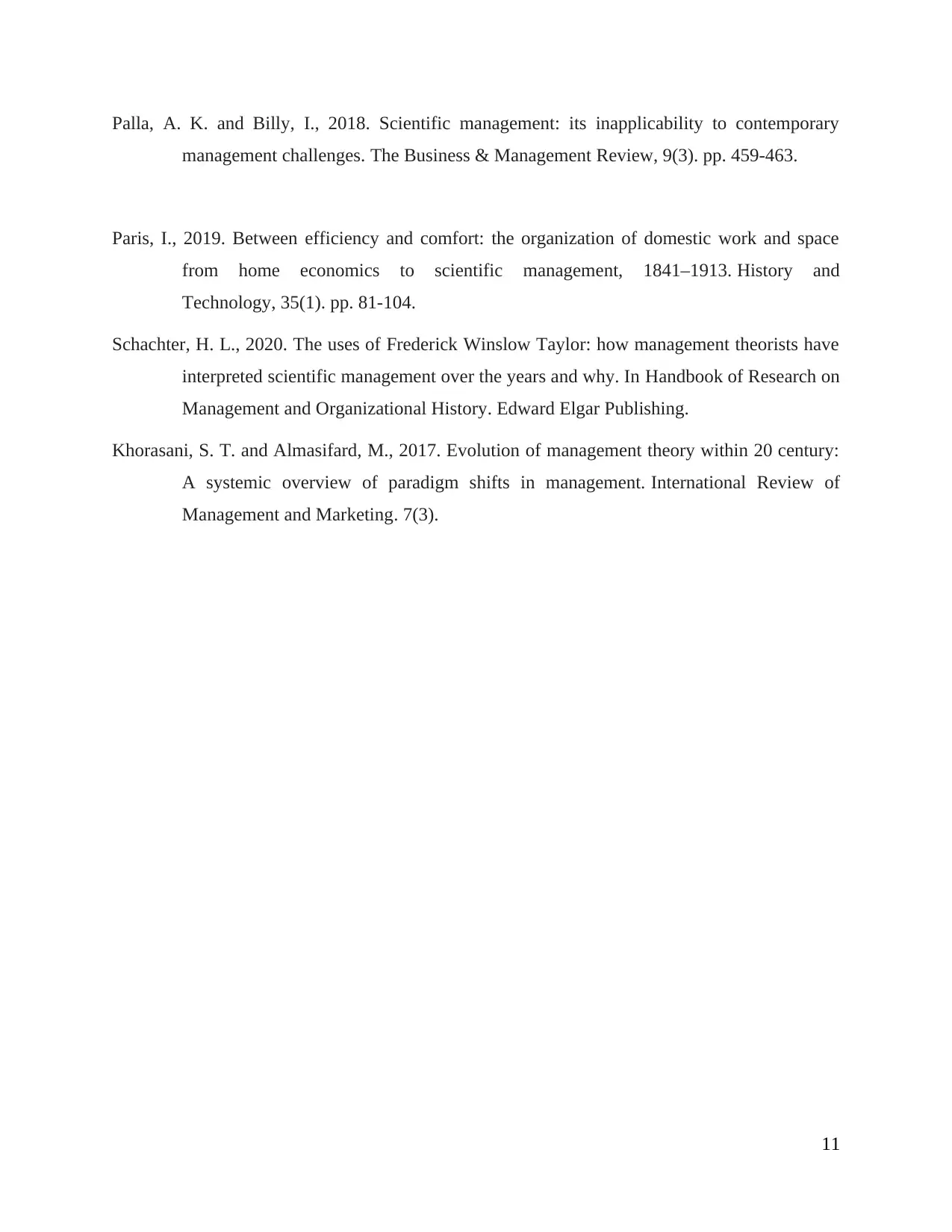
Palla, A. K. and Billy, I., 2018. Scientific management: its inapplicability to contemporary
management challenges. The Business & Management Review, 9(3). pp. 459-463.
Paris, I., 2019. Between efficiency and comfort: the organization of domestic work and space
from home economics to scientific management, 1841–1913. History and
Technology, 35(1). pp. 81-104.
Schachter, H. L., 2020. The uses of Frederick Winslow Taylor: how management theorists have
interpreted scientific management over the years and why. In Handbook of Research on
Management and Organizational History. Edward Elgar Publishing.
Khorasani, S. T. and Almasifard, M., 2017. Evolution of management theory within 20 century:
A systemic overview of paradigm shifts in management. International Review of
Management and Marketing. 7(3).
11
management challenges. The Business & Management Review, 9(3). pp. 459-463.
Paris, I., 2019. Between efficiency and comfort: the organization of domestic work and space
from home economics to scientific management, 1841–1913. History and
Technology, 35(1). pp. 81-104.
Schachter, H. L., 2020. The uses of Frederick Winslow Taylor: how management theorists have
interpreted scientific management over the years and why. In Handbook of Research on
Management and Organizational History. Edward Elgar Publishing.
Khorasani, S. T. and Almasifard, M., 2017. Evolution of management theory within 20 century:
A systemic overview of paradigm shifts in management. International Review of
Management and Marketing. 7(3).
11
1 out of 11
Related Documents
Your All-in-One AI-Powered Toolkit for Academic Success.
+13062052269
info@desklib.com
Available 24*7 on WhatsApp / Email
![[object Object]](/_next/static/media/star-bottom.7253800d.svg)
Unlock your academic potential
© 2024 | Zucol Services PVT LTD | All rights reserved.





